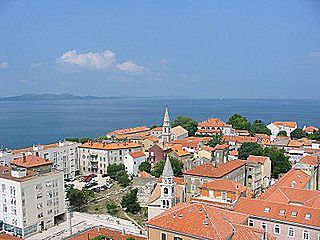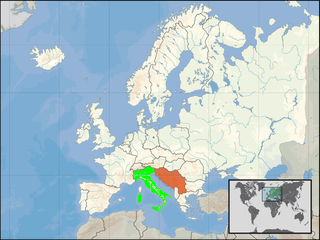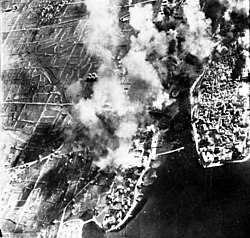
Zadar, historically known as Zara, is the oldest continuously inhabited city in Croatia. It is situated on the Adriatic Sea, at the northwestern part of Ravni Kotari region. Zadar serves as the seat of Zadar County and of the wider northern Dalmatian region. The city proper covers 25 km2 (9.7 sq mi) with a population of 75,082 in 2011, making it the second-largest city of the region of Dalmatia and the fifth-largest city in the country.

The Independent State of Croatia was a World War II-era puppet state of Nazi Germany and Fascist Italy. It was established in parts of occupied Yugoslavia on 10 April 1941, after the invasion by the Axis powers. Its territory consisted of most of modern-day Croatia and Bosnia and Herzegovina, as well as some parts of modern-day Serbia and Slovenia, but also excluded many Croat-populated areas in Dalmatia, Istria, and Međimurje regions.

The Istrian–Dalmatian exodus was the post-World War II exodus and departure of local ethnic Italians as well as ethnic Slovenes and Croats from Yugoslavia. The emigrants, who had lived in the now Yugoslav territories of the Julian March, Kvarner and Dalmatia, largely went to Italy, but some joined the Italian diaspora in the Americas, Australia and South Africa. These regions were ethnically mixed, with long-established historic Croatian, Italian, and Slovene communities. After World War I, the Kingdom of Italy annexed Istria, Kvarner, the Julian March and parts of Dalmatia including the city of Zadar. At the end of World War II, under the Allies' Treaty of Peace with Italy, the former Italian territories in Istria, Kvarner, the Julian March and Dalmatia were assigned to now Communist-helmed Federal Yugoslavia, except for the Province of Trieste. The former territories absorbed into Yugoslavia are part of present-day Croatia and Slovenia.

World War II in the Kingdom of Yugoslavia began on 6 April 1941, when the country was invaded and swiftly conquered by Axis forces and partitioned among Germany, Italy, Hungary, Bulgaria and their client regimes. Shortly after Germany attacked the USSR on 22 June 1941, the communist-led republican Yugoslav Partisans, on orders from Moscow, launched a guerrilla liberation war fighting against the Axis forces and their locally established puppet regimes, including the Axis-allied Independent State of Croatia (NDH) and the Government of National Salvation in the German-occupied territory of Serbia. This was dubbed the National Liberation War and Socialist Revolution in post-war Yugoslav communist historiography. Simultaneously, a multi-side civil war was waged between the Yugoslav communist Partisans, the Serbian royalist Chetniks, the Axis-allied Croatian Ustaše and Home Guard, Serbian Volunteer Corps and State Guard, Slovene Home Guard, as well as Nazi-allied Russian Protective Corps troops.

Dalmatian Italians are the historical Italian national minority living in the region of Dalmatia, now part of Croatia and Montenegro.

The Air Force of the Independent State of Croatia, was the air force of the Independent State of Croatia (NDH), a puppet state established with the support of the Axis Powers on the territory of the Kingdom of Yugoslavia during World War II. The ZNDH was founded under German authority in April 1941, following the German-led Axis invasion of Yugoslavia.

The Navy of the Independent State of Croatia, was the navy of the Independent State of Croatia, an Axis puppet state controlled by the fascist Ustaše party. The NDH was created from parts of the Kingdom of Yugoslavia on 10 April 1941, four days after the World War II invasion of Yugoslavia by the Axis powers commenced. The RMNDH consisted of two commands, the Coast and Maritime Traffic Command, and the River and River Traffic Command, and had its headquarters in the NDH capital, Zagreb. The Coast and Maritime Traffic Command consisted of three naval commands along the Adriatic coast, which were each divided into a number of naval districts. The naval districts consisted mainly of naval and weather stations, and were only responsible for coast guard and customs duties. The River and River Traffic Command consisted of seven river stations, a naval infantry battalion, and a River Command Flotilla built around two former Yugoslav river monitors, which had been scuttled during the invasion but subsequently refloated.

The Governorate of Dalmatia was a territory divided into three provinces of Italy during the Italian Kingdom and Italian Empire epoch. It was created later as an entity in April 1941 at the start of World War II in Yugoslavia, by uniting the existing Province of Zara together with occupied Yugoslav territory annexed by Italy after the invasion of Yugoslavia by the Axis powers and the signing of the Rome Treaties.

Italy–Yugoslavia relations are the cultural and political relations between Italy and Yugoslavia in the 20th century, since the creation of Yugoslavia in 1918 until its dissolution in 1992. Relations during the interwar years were hostile because of Italian irredentist demands to Yugoslav territory, leading to Fascist Italy and the Axis Powers invading Yugoslavia during World War II. After lingering tensions after the war over the status of the Free Territory of Trieste, relations improved during the Cold War.

The bombing of Podgorica in World War II was carried out by the Allies from 1943 to 1944 at the request of the Yugoslav Partisans.
Arbanasi is an ethnic community in and around the city of Zadar region in northern Dalmatia region of Croatia who are of Albanian ethnic origin. They are traditional speakers of the Arbanasi dialect of Gheg Albanian. Their name is an obsolete way to say Albanians in Croatian and is the toponymy of the first Arbanasi settlement in the region, which today is a suburb of Zadar. In Albanian literature, they are known as "Albanians of Zadar".

The Adriatic campaign of World War II was a minor naval campaign fought during World War II between the Greek, Yugoslavian and Italian navies, the Kriegsmarine, and the Mediterranean squadrons of the United Kingdom, France, and the Yugoslav Partisan naval forces. Considered a somewhat insignificant part of the naval warfare in World War II, it nonetheless saw interesting developments, given the specificity of the Dalmatian coastline.
Air warfare during World War II in Yugoslavia pitted the Yugoslav Air Force, both Royal and NOVJ, United States Army Air Force (USAAF), the Royal Air Force (RAF), including the Balkan Air Force, and Soviet Air Forces against the German Luftwaffe, the Italian Regia Aeronautica and the Air Force of the Independent State of Croatia. The latter provided the majority of the support for the ground operations against the Partisans. The Allied forces engaged in an extensive bombing campaign in an effort to weaken the Axis hold on the country.

Girolamo Luxardo S.p.A. is an Italian liqueur factory. Founded in Zara, it moved to Torreglia near Padua after 1945.

The Province of Zara was a province of the Kingdom of Italy, officially from 1918 to 1947. In 1941 it was enlarged and made part of the Italian Governorate of Dalmatia, during World War II, until 1943.
The Allied bombing of Yugoslavia in World War II involved air attacks on cities and towns in the Kingdom of Yugoslavia by the United States Army Air Force (USAAF) and Royal Air Force (RAF), including the Balkan Air Force (BAF), between 1941 and 1945, during which period the entire country was occupied by the Axis powers. Dozens of Yugoslav cities and towns were bombed, many repeatedly. These attacks included intensive air support for Yugoslav Partisan operations in May–June 1944, and a bombing campaign against transport infrastructure in September 1944 as the German Wehrmacht withdrew from Greece and Yugoslavia. This latter operation was known as Operation Ratweek. Some of the attacks caused significant civilian casualties.
The 1941 Treaties of Rome were a series of treaties concluded by the Fascist Italian regime and the World War II collaborationist Independent State of Croatia on 18 May 1941, following the Axis Invasion of Yugoslavia. The treaties determined the borders between the NDH and Italy, effectively ceding territory largely organised as the Governorate of Dalmatia to the latter. They also prohibited the NDH from deploying naval forces to the Adriatic Sea, and restricted movement of its troops in the Italian-controlled part of the NDH.
Stevo Rađenović was a Yugoslav Radical Union politician during the interwar period and a Chetnik leader in the Lika region of the Axis puppet state, the Independent State of Croatia during World War II. He was a prominent leader of the July 1941 Srb uprising against the genocidal Ustaše-led NDH government, and was the first Chetnik leader in the region to reach an understanding with the Royal Italian Army in order to collaborate with them against the Yugoslav Partisans.

Giacomo Vuxani was an Italian politician and patriot born in the Arbanasi village of Borgo Erizzo, a suburb of Zadar.
The official figure of war related deaths during World War II in Yugoslavia and the immediate post-war period, provided by the Yugoslav government in 1946, was 1,706,000 deaths. This number was proven to be exaggerated in later studies, particularly by statistician Bogoljub Kočović, who in 1985 estimated the actual war losses of the pre-war territory of the Kingdom of Yugoslavia at 1,014,000, and demographer Vladimir Žerjavić, whose 1989 estimate was 1,027,000 deaths. Kočović did not separate civilian and military deaths, while Žerjavić estimated that 53% were civilians, and 47% were members of various military forces.














